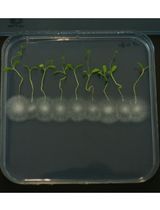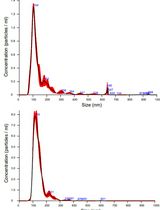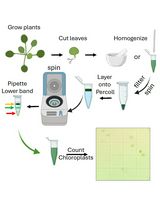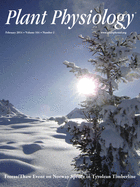- Submit a Protocol
- Receive Our Alerts
- Log in
- /
- Sign up
- My Bio Page
- Edit My Profile
- Change Password
- Log Out
- EN
- EN - English
- CN - 中文
- Protocols
- Articles and Issues
- For Authors
- About
- Become a Reviewer
- EN - English
- CN - 中文
- Home
- Protocols
- Articles and Issues
- For Authors
- About
- Become a Reviewer
Isolation of Mitochondria from Potato Tubers
Published: Vol 4, Iss 17, Sep 5, 2014 DOI: 10.21769/BioProtoc.1226 Views: 19778
Reviewed by: Zhaohui LiuTie Liu

Protocol Collections
Comprehensive collections of detailed, peer-reviewed protocols focusing on specific topics
Related protocols

Closed Systems to Study Plant–Filamentous Fungi Associations: Emphasis on Microscopic Analyses
Vasiliki Skiada and Kalliope K. Papadopoulou
Feb 20, 2025 2527 Views

Isolation and Biophysical Characterization of Extracellular Vesicles From Hairy Root Cultures
Marisa Conte [...] Alfredo Ambrosone
Mar 5, 2025 1964 Views

Rapid Miniprep of Intact Chloroplasts from Arabidopsis thaliana Leaves
Brenda A. Carranza-Correa [...] Manuel Gutiérrez-Aguilar
May 20, 2025 2399 Views
Abstract
One way to study the function of plant mitochondria is to extract them from plant tissues in an uncontaminated, intact and functional form. The reductionist assumption is that the components present in such a preparation and the in vitro measurable functions or activities reliably reflect the in vivo properties of the organelle inside the plant cell. Here, we describe a method to isolate mitochondria from a relatively homogeneous plant tissue, the dormant potato tuber. The homogenization is done using a juice extractor, which is a relatively gentle homogenization procedure where the mitochondria are only exposed to strong shearing forces once. After removal of starch and large tissue pieces by filtration, differential centrifugation is used to remove residual starch as well as larger organelles. The crude mitochondria are then first purified by using a step Percoll gradient. The mitochondrial band from the step gradient is further purified by using a continuous Percoll gradient. The gradients remove contaminating amyloplasts and peroxisomes as well as ruptured mitochondria. The result is a highly purified, intact and functional mitochondrial preparation, which can be frozen and stored in liquid nitrogen in the presence of 5% (v/v) dimethylsulfoxide to preserve integrity and functionality for months.
Keywords: MitochondriaMaterials and Reagents
- Mannitol
- 3-morpholinopropane-1-sulfonic acid (MOPS)
- Potassium hydroxide (KOH)
- Bovine serum albumin (BSA)
- Ethylenediaminetetraacetic acid (EDTA)
- Cysteine
- Percoll
- Sucrose
- Dimethylsulfoxide (DMSO)
- Liquid nitrogen
- Extraction medium (see Recipes)
- Wash buffer (see Recipes)
- Gradient buffers (see Recipes)
- Percoll gradients (see Recipes)
Equipment
- Potato tubers
- 6 x 250 ml precooled angle rotor (e.g., Beckman Coulter, model: JA-14 or Thermo Fisher Scientific, model: SLA-1500 )
- 8 x 50 ml pre-cooled angle rotor (e.g., Beckman Coulter, model: JA-20 or Thermo Fisher Scientific, model: SS-34 )
- Juice extractor (kitchen appliance, e.g. Maginix Le duo XL)
- Centrifuge (for 50 and 250 ml tubes) (e.g. Beckman Coulter or SorvallTM)
- Paint brush (soft)
- Cotton cloth or nylon net (e.g., mesh 60-120 μm)
- Plastic Pasteur pipettes
- Beakers
- Measuring pipette
- pH meter
- Potato peeler
- Funnel
Procedure
Notes:
- All steps should be performed at 0-4 °C using detergent-free glass-ware or plastic!
- We will here describe the isolation of mitochondria from 1 kg of peeled tubers of the cultivar Folva. This will give a final yield of 8-12 mg mitochondrial proteins. Using other cultivars can give different yields. Total time from start of the homogenization (point 3) to freezing about 6 h.
- Pre-cool centrifuge rotor.
- Add cysteine and BSA to extraction buffer, adjust to pH 7.3. Cysteine is an antioxidant and BSA binds fatty acids and phenolics, which can interfere with mitochondrial function, BSA also works as a protease substrate to help protect the mitochondrial proteins from damage.
- Peel potatoes and homogenize the peeled potato using a juice extractor (1 kg gives approximately 500 ml juice) and let the juice run directly into about 1/2 volume extraction medium (250 ml here). Adjust to pH 7.2 using 2 M KOH immediately afterwards or, for larger preparations, after each kg homogenized.
- Leave homogenate (total volume about 750 ml) standing for 5 min allowing starch to sediment.
- Filter through two layers of cotton (or similar) using a funnel and transfer to centrifuge tubes.
- Transfer ~190 ml filtrate to each of four 250 ml centrifuge tubes. Balance tubes, and centrifuge at 3,000 x g for 5 min in a 6 x 250 ml precooled angle rotor.
- Pour supernatants carefully into fresh centrifuge tubes (avoid transferring the pellets), balance and centrifuge at 18,000 x g for 10 min.
- Discard the supernatants gently without disturbing the pellets and resuspend each pellet in 1 ml of 1x mannitol gradient buffer using a paint brush. Total volume of resuspended pellets 8-10 ml.
- Prepare two Percoll step gradients using plastic Pasteur pipettes. Avoid mixing the bands by gently layering first the 50%, then the 28% and finally the 20% Percoll (all in mannitol) on top of each other in 50 ml centrifuge tubes.
- Gently layer the crude fraction (4-5 ml maximum per gradient) on top of the two Percoll step gradients.
- Balance tubes and centrifuge at 40,000 x g for 30 min using an 8 x 50 ml pre-cooled angle rotor (see Figure 1A).
- Transfer the mitochondrial band from each tube using a Pasteur pipette to new 50 ml tubes, fill up to 40 ml with wash buffer and mix.
- Balance the two tubes against each other and centrifuge at 18,000 x g for 10 min.
- Carefully remove supernatant, resuspend the very loose pellets with wash buffer, fill up to 40 ml with wash buffer and mix.
- Balance and centrifuge at 18,000 x g for 10 min (see Figure 1B).
- Remove supernatant and resuspend the very loose pellets using a paint brush in 1 ml 1 x mannitol buffer and gently layer on top of two 28% Percoll sucrose gradients.
- Balance and centrifuge at 40,000 x g for 30 min using the 8 x 50 ml rotor (see Figure 1C).
- Transfer the mitochondrial bands to two fresh 50 ml centrifuge tubes, fill up to 40 ml with wash buffer and mix.
- Centrifuge at 18,000 x g for 10 min.
- Carefully remove supernatant and repeat wash (as steps 13-14) of pellets (see Figure 1D).
- Remove supernatant and resuspend each pellet in 500 µl wash buffer. Add 5% (v/v) DMSO for freezing of the intact organelles. The final volume from each pellet is around 800 µl containing 4-6 mg (total 8-12 mg) mitochondrial protein.
- Snap freeze and store aliquots of 100-200 µl in liquid nitrogen. In this way, the mitochondria maintain their intactness and respiratory function (see below) for months, if quickly thawed shortly before use.

Figure 1. Percoll gradient purification of potato tuber mitochondria. A). Step gradient with a yellowish mitochondrial band at the 28% - 50% Percoll interface and a starch pellet (after step 11). B). The pellet obtained after removing the mitochondrial band from the step gradient and washing it (after step 15). The dark center consists of peroxisomes (Struglics et al., 1993). C). Continuous gradient with a whitish mitochondrial band (after step 17). D). The final pellet obtained after removing the mitochondrial band from the continuous gradient and washing it (after step 20).
Representative data
Properties of the isolated mitochondria
- The mitochondria isolated from potato tubers using this protocol have highly intact outer membranes as judged by >97% latency of cytochrome c oxidase and are highly purified as judged by the high specific activity of cytochrome c oxidase (3.5 µmol mg-1 min-1). The respiration rates in state 3 (presence of ADP) using single substrates (NADH, succinate and malate) are 150-350 nmol O2 mg-1 min-1, the respiratory control ratio of 2.5-3.5 and the ADP/O ratio 1.7-2.0 all depending on the substrate, the preparation and the cultivar. This is fully consistent with previous studies (Neuburger et al., 1982; Rasmusson and Møller, 1990; Struglics et al., 1993).
- The mitochondria were judged to be >95% pure by western blotting (Salvato et al., 2014), which is consistent with measurements of marker enzymes and marker compounds in previous studies (Neuburger et al., 1982; Struglics et al., 1993).
- Using one-dimensional polyacrylamide gel electrophoresis to separate the mitochondrial proteins according to size followed by tryptic digestion, separation of the tryptic peptides by liquid chromatography and identification by mass spectrometry a total of 1,060 different proteins were identified including about 500 proteins not previously identified in plant mitochondria (Salvato et al., 2014).
- Similar methods can be used to isolate mitochondria from other tissues and species. However, the homogenization methods will probably have to be changed as does the Percoll concentration used to collect the mitochondria and purify them further (28% here). See Meyer and Millar (2008) for a method for isolating mitochondria from Arabidopsis cell cultures. Isolating mitochondria from green leaves is more difficult because of the large amount of chloroplasts and thylakoid membranes released from the tissue, and Arabidopsis leaves are particularly difficult (Keech et al., 2005).
Recipes
- Extraction medium [600 (300) ml, pH 7.3]
Chemical Concentration g/L Mannitol 0.9 M 163.95 MOPS 30 mM 6.28 EDTA 3 mM 0.87 L-Cysteine 25 mM 3.03 BSA 0.3 % (w/v) 3.00
Dissolve mannitol, MOPS and EDTA in double-distilled water (ddH2O)
Adjust pH to 7.2 and transfer 300 ml to new container to use as wash buffer
On day of use add cysteine and BSA to the remaining 300 ml, adjust to pH 7.3 with KOH. - Wash buffer (900 ml, pH 7.2)
Chemical Concentration g/L Mannitol 0.3 M 54.65 MOPS 10 mM 2.07 EDTA 1 mM 0.29
Use extraction medium (no cysteine and BSA) and dilute 3-fold by adding ddH2O
Include 0.1% BSA if the mitochondria are to be used in a non-proteomics context - Gradient buffers
- 2x mannitol buffer (150 ml, pH 7.2)
Chemical Concentration g/L Mannitol 0.6 M 109.3 MOPS 20 mM 4.14 BSA 0.2 % (w/v) 2.0
Use 35 ml for each of the two step gradients and dilute the remaining 115 ml 2-fold to use for resuspending pellets. - 2x sucrose buffer (100 ml, pH 7.2)
Chemical Concentration g/L Sucrose 0.6 M 205.4 MOPS 20 mM 4.14 BSA 0.2 % (w/v) 2.0
- 2x mannitol buffer (150 ml, pH 7.2)
- Percoll gradients
Total volume 35 ml without samples- Step gradient
Percoll, % (v/v) ddH2O, % 2x mannitol buffer, % Volume per gradient, ml 20 30 50 17.5 28 22 50 11.67 50 - 50 5.83 - Continuous gradient
Percoll, % (v/v) ddH2O, % 2x mannitol buffer, % Volume per gradient, ml 28 22 50 35
Very carefully add the three layers of the step gradient one by one (highest first) holding the 50 ml tube at a 45 degree angle to avoid mixing
- Step gradient
Acknowledgments
This work was supported by the Danish Council for Independent Research - Natural Sciences (to I.M.M.) and the OECD Cooperative Research Programme: Biological Resource Management for Sustainable Agricultural Systems (2012 sabbatical fellowship to J.J.T.).
The method was published in Neuburger et al. (1982) and it is an adaptation of the methods used by Neuburger et al. (1982), Struglics et al. (1993) and Considine et al. (2002).
References
- Considine, M. J., Goodman, M., Echtay, K. S., Laloi, M., Whelan, J., Brand, M. D. and Sweetlove, L. J. (2003). Superoxide stimulates a proton leak in potato mitochondria that is related to the activity of uncoupling protein. J Biol Chem 278(25): 22298-22302.
- Keech, O., Dizengremel, P. and Gardeström, P. (2005). Preparation of leaf mitochondria from Arabidopsis thaliana. Physiologia Plantarum 124(4): 403-409.
- Meyer, E. H. and Millar, A. H. (2008). Isolation of mitochondria from plant cell culture. In: Posch (ed). Methods Mol Biol. Humana Press. vol. 425: 2D PAGE: Sample Preparation and Fractionation, Volume 2A.
- Neuburger, M., Journet, E. P., Bligny, R., Carde, J. P. and Douce, R. (1982). Purification of plant mitochondria by isopycnic centrifugation in density gradients of Percoll. Arch Biochem Biophys 217(1): 312-323.
- Rasmusson, A. G. and Møller, I. M. (1990). NADP-utilizing enzymes in the matrix of plant mitochondria. Plant Physiol 94(3): 1012-1018.
- Salvato, F., Havelund, J. F., Chen, M., Rao, R. S., Rogowska-Wrzesinska, A., Jensen, O. N., Gang, D. R., Thelen, J. J. and Møller, I. M. (2014). The potato tuber mitochondrial proteome. Plant Physiol 164(2): 637-653.
- Struglics, A., Fredlund, K. M., Rasmusson, A. G. and Møller, I. M. (1993). The presence of a short redox chain in the membrane of intact potato tuber peroxisomes and the association of malate dehydrogenase with the peroxisomal membrane. Physiologia Plantarum 88(1): 19-28.
Article Information
Copyright
© 2014 The Authors; exclusive licensee Bio-protocol LLC.
How to cite
Readers should cite both the Bio-protocol article and the original research article where this protocol was used:
- Havelund, J. F., Salvato, F., Chen, M., Rao, R., Rogowska-Wrzesinska, A., Jensen, O. N., Gang, D. R., Thelen, J. J. and Møller, I. M. (2014). Isolation of Mitochondria from Potato Tubers. Bio-protocol 4(17): e1226. DOI: 10.21769/BioProtoc.1226.
- Salvato, F., Havelund, J. F., Chen, M., Rao, R. S., Rogowska-Wrzesinska, A., Jensen, O. N., Gang, D. R., Thelen, J. J. and Møller, I. M. (2014). The potato tuber mitochondrial proteome. Plant Physiol 164(2): 637-653.
Category
Plant Science > Plant cell biology > Organelle isolation
Plant Science > Plant cell biology > Tissue analysis
Cell Biology > Organelle isolation > Mitochondria
Do you have any questions about this protocol?
Post your question to gather feedback from the community. We will also invite the authors of this article to respond.
Tips for asking effective questions
+ Description
Write a detailed description. Include all information that will help others answer your question including experimental processes, conditions, and relevant images.
Share
Bluesky
X
Copy link








